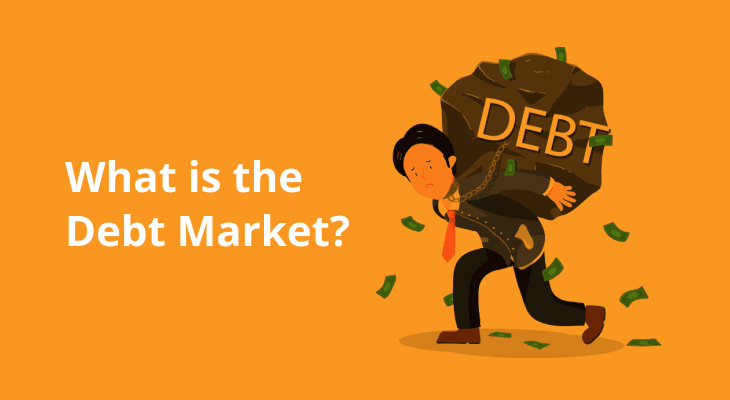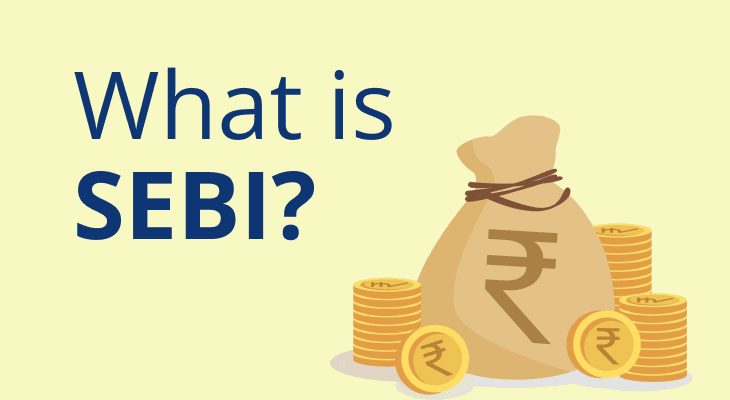
Table of content
- What is the Debt Market?
- How Does the Debt Market Work?
- Types of Debt Instruments
- Key Players in the Debt Market
- Benefits of Investing in the Debt Market
- Risks Associated with the Debt Market
- Debt Market vs. Equity Market
- Role of the Debt Market in the Economy
- How to Invest in the Debt Market
- Conclusion
What is the Debt Market?
Today, there are various investment options available for investors. While most people are familiar with the stock market, not everyone understands an equally important segment – the debt market. The debt market, also known as the bond market or fixed-income market, is a place where participants buy and sell debt securities, typically in the form of bonds. In simpler terms, it is a marketplace for loans in the form of bonds, notes, and bills. This market plays a crucial role in the functioning of the global economy, offering investors a chance to lend money in exchange for interest payments and the eventual return of principal.
In this guide, we'll break down the debt market, how it operates, its benefits and risks, and how you can invest in it. Let’s get started by understanding the basics of the debt market and its significance.
What is the Debt Market?
The debt market is a platform where investors trade debt securities such as bonds, treasury bills, and notes. In essence, it is the place where the government, companies, and other institutions can raise funds by issuing debt instruments, and where investors can purchase these instruments to earn interest income.
In the debt market, the borrower agrees to pay back the loan with interest at regular intervals until the debt matures. For example, when you buy a government bond, you are lending money to the government in exchange for periodic interest payments and a promise to return the principal amount when the bond matures. This is in contrast to the equity market, where companies issue shares to raise capital, and investors gain ownership in the company.
The debt market is an essential source of funding for governments and corporations, helping them raise money for various purposes such as infrastructure projects, business expansion, or refinancing debt.
How Does the Debt Market Work?
The debt market operates through the issuance of debt securities by governments, corporations, and other entities. These debt securities are then bought and sold by investors in the secondary market.
- Primary Market: In this market, new debt instruments are issued directly to investors. When a company or government needs to raise funds, it issues bonds or other debt securities through a public offering or private placement. The price of these securities is determined by the issuer, and investors buy them at the issue price. For example, when the government issues new bonds, they are sold in the primary market, and investors commit to lending money in exchange for the promise of interest payments.
- Secondary Market: Once the debt instruments are issued, they are traded among investors in the secondary market. This market is similar to the stock market, where bonds or notes are bought and sold between investors, typically through brokerage firms. The prices of debt instruments in the secondary market fluctuate based on various factors, including interest rates, credit risk, and the overall economic environment.
Types of Debt Instruments
There are various types of debt instruments in the market, each offering different levels of risk and return. Some of the most common debt instruments include:
- Bonds: Bonds are long-term debt securities issued by governments, municipalities, and corporations. Bondholders receive periodic interest payments (called coupons) and are repaid the principal amount at maturity. Bonds can be further categorised into government bonds, corporate bonds, and municipal bonds, depending on the issuer.
- Treasury Bills (T-Bills): These are short-term debt instruments issued by the government to raise funds for a short duration, typically less than one year. T-bills are sold at a discount, and the investor receives the full face value at maturity. The difference between the purchase price and face value represents the interest earned.
- Treasury Notes: These are medium-term debt securities issued by the government with maturities ranging from one to ten years. Treasury notes pay interest every six months and return the principal amount at maturity.
- Commercial Paper: This is a short-term debt instrument issued by corporations to meet their short-term financing needs. Typically, commercial paper is issued for periods ranging from a few days to a year, and it is unsecured, meaning it is not backed by collateral.
- Debentures: These are long-term, unsecured debt instruments issued by corporations. Debentures pay periodic interest and return the principal amount at maturity. They are riskier than secured bonds but tend to offer higher returns to investors.
Key Players in the Debt Market
The debt market is made up of various participants, each playing a crucial role in its functioning:
- Issuers: These are the entities (governments, corporations, municipalities) that issue debt securities to raise capital. Governments issue bonds to fund infrastructure, pay off existing debt, or meet other financial needs. Corporations issue bonds or commercial paper to raise capital for expansion or other operational needs.
- Investors: These are the individuals or institutions that buy debt securities. Investors can be retail investors (individuals) or institutional investors (mutual funds, insurance companies, pension funds, etc.). Investors purchase debt securities with the goal of earning interest income and potentially benefiting from price appreciation.
- Regulators: Regulators, such as central banks and financial regulatory authorities, play a significant role in ensuring the stability and transparency of the debt market. They set interest rates, establish rules and guidelines, and monitor market activity to prevent fraudulent practices.
- Brokers and Dealers: These are the intermediaries that facilitate the buying and selling of debt securities. Brokers work with investors to buy and sell debt instruments, while dealers act as market makers, offering to buy and sell securities at specified prices.
Benefits of Investing in the Debt Market
Investing in the debt market has several advantages, particularly for conservative investors looking for stable income. Some of the key benefits include:
- Steady Income: Debt instruments, particularly bonds and treasury bills, provide a steady stream of income through interest payments. This makes them an attractive option for investors seeking regular income, such as retirees.
- Lower Risk: Debt instruments are generally considered safer than stocks because they offer fixed returns and the principal is repaid at maturity (provided the issuer does not default). Government bonds, in particular, are considered low-risk investments.
- Capital Preservation: For investors who are risk-averse and prioritise the preservation of capital, the debt market offers an ideal investment option. Bonds and other debt instruments are less volatile than stocks, making them a good option for conservative investors.
- Diversification: Adding debt instruments to an investment portfolio can help diversify risk. Diversification is important for reducing the overall volatility of the portfolio, as bonds often behave differently from stocks in various market conditions.
Risks Associated with the Debt Market
While the debt market offers several advantages, it is not without its risks. Investors should be aware of the potential risks involved in debt investments:
- Credit Risk: This refers to the risk that the issuer of the debt instrument may default on its interest payments or fail to repay the principal at maturity. Corporate bonds and commercial paper carry higher credit risk compared to government bonds.
- Interest Rate Risk: The prices of debt instruments, particularly long-term bonds, are sensitive to changes in interest rates. When interest rates rise, the value of existing bonds tends to fall, as newer bonds offer higher yields. Conversely, when interest rates fall, the value of existing bonds rises.
- Liquidity Risk: Some debt instruments, especially those issued by smaller companies or in less liquid markets, may be difficult to sell quickly. Investors may face difficulties if they need to sell their debt securities before maturity.
- Inflation Risk: Inflation erodes the purchasing power of fixed-income payments. If inflation rises significantly, the real value of the interest payments received from debt securities may be lower than expected.
Debt Market vs. Equity Market
The debt market and the equity market are two distinct financial markets, each offering different types of investments. Here are the key differences between them:
- Ownership: In the equity market, investors buy shares of a company, gaining ownership and a claim on the company’s profits. In the debt market, investors lend money to the issuer in exchange for interest payments, but they do not gain ownership in the company.
- Risk and Return: Debt instruments are typically considered safer investments compared to stocks. While stocks can offer higher potential returns, they come with higher volatility and risk. Bonds, on the other hand, offer fixed returns but are generally less risky.
- Income vs. Capital Appreciation: Debt investments provide regular income through interest payments, while equity investments provide potential capital appreciation and dividends.
- Priority in Bankruptcy: In case of bankruptcy, debt holders are paid before equity shareholders. This makes debt investments less risky compared to equity investments in terms of recovery in adverse situations.
Role of the Debt Market in the Economy
The debt market plays a critical role in the economy by providing a mechanism for governments and businesses to raise capital. This capital is often used to finance infrastructure projects, business expansions, and other productive activities. The debt market also helps to:
- Promote Economic Growth: By enabling governments and corporations to borrow funds for investments, the debt market stimulates economic growth.
- Support Financial Stability: The debt market provides a stable investment option for investors, helping them to preserve capital while receiving regular returns.
- Facilitate Monetary Policy: The debt market is used by central banks to implement monetary policy that directly influences interest rates and helps in controlling inflation.
How to Invest in the Debt Market
Investing in the debt market can be done in several ways:
- Direct Purchase of Bonds: You can directly buy government bonds, corporate bonds, or municipal bonds. These can be purchased through brokerage firms or directly from the government in some cases.
- Bond Mutual Funds: If you're not interested in selecting individual bonds, bond mutual funds pool money from multiple investors to invest in a diversified portfolio of debt securities.
- Exchange-Traded Funds (ETFs): Bond ETFs and bond mutual funds are quite similar, but ETFs trade on stock exchanges like individual stocks. They offer liquidity and diversification.
Conclusion
The debt market is an essential component of the financial system, offering a stable and lower-risk investment option compared to the equity market. Understanding how it works, the different types of debt instruments, and the associated risks can help you make informed investment decisions. Whether you're looking for steady income or a way to diversify your portfolio, the debt market offers a range of opportunities suited to different investor preferences. Always assess the risks and consult with a financial advisor to ensure that debt market investments align with your financial goals.
FAQ
What is the debt market?
In the debt market, companies, governments, and other institutions issue debt securities (like bonds, notes, and treasury bills) to raise capital. The primary function of this market is to provide a platform for borrowing and lending capital.
How does the debt market work?
The debt market functions by facilitating the buying and selling of debt instruments. Governments and corporations issue debt securities to raise funds. Investors, in return, lend money to the issuer and receive regular interest payments, with the principal returned at the bond’s maturity.
What are the different types of debt instruments in the market?
Debt instruments in the market vary, with some of the most common being bonds, treasury bills, commercial papers, certificates of deposit, and notes. Bonds are long-term debt instruments, treasury bills are short-term government securities, commercial papers are unsecured short-term debts issued by corporations, and certificates of deposit are time deposits issued by banks.
Who are the main players in the debt market?
The main players in the debt market include issuers such as governments, corporations, and financial institutions; investors, such as individual investors, mutual funds, pension funds, and institutional investors; and brokers, dealers, and rating agencies.
What are the benefits of investing in the debt market?
Benefits include stable income through interest payments, diversification of investment portfolios, and lower risk compared to equities. Debt instruments, especially government bonds, are considered relatively safe investments. Furthermore, they offer liquidity and a predictable return, making them attractive to conservative investors seeking capital preservation.
What are the risks associated with the debt market?
Risks include, interest rate risk – when market interest rates rise, causing the value of existing debt instruments to fall. Credit risk – the issuer may default on its debt obligations. Inflation risk – can erode the real return on fixed-income securities, and liquidity risk – the inability to sell securities at a fair price due to market conditions.
How does the debt market differ from the equity market?
The debt market involves borrowing and lending, where investors lend money in exchange for interest payments and repayment of principal. The equity market involves buying shares of companies, where investors own a portion of the company and may receive dividends. While debt market investments are considered safer, equity market investments offer higher potential returns.
What role does the debt market play in the economy?
The debt market facilitates the flow of capital between borrowers and lenders. It enables governments and businesses to raise funds for development, infrastructure projects, and expansion. The market also helps in setting interest rates and determining the cost of capital for both businesses and consumers.
How can an individual invest in the debt market?
Individuals can invest in the debt market by purchasing bonds directly from issuers, buying debt mutual funds, or investing in exchange-traded funds (ETFs) that focus on debt securities. Investors can also use brokerage accounts to trade bonds or invest in debt-focused ETFs.
What are government bonds, and how do they function in the debt market?
Government bonds are debt securities issued by national governments to finance public spending and obligations. These bonds are considered low-risk because they are backed by the government’s credit. They offer periodic interest payments, and at maturity, the principal amount is returned.


